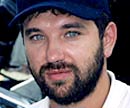|
Field works.
The expedition is provided with necessary
equipment for realization of the complex of works in the field
conditions. In case of discovery of the grave of the participants
of the Lassenius detachment all necessary works to determine
the reasons of their death, including radiography, would be
carried out on the spot.
For the first time scientists would use
the method of reconstruction of the lifetime portraits of
the dead sailors by their sculls in the field conditions.
An expert will put photographs of skulls in a computer, which,
with the help of the unique program, will make a three-dimensional
portraits of a photographic quality. All finds of domestic
objects of that historical period (parts of clothes, footwear,
knifes, bullets and etc.) after conservation at the laboratory
of the Archaeological Institute of the Russian Academy of
Sciences, would be passed to the museums of the Sakha Republic
(Yakutia).
Scientific program.
Archaeological part
(Scientific leader – V.F.Starkov, Ph.D.History, professor).
Objectives:
- Research of the territory of the mouth of the Khara-Ulakh
River, correlation of the locality with the chart.
- Search of the traces of buildings of 1735: foundations
of the two houses, remains of the lighthouse (9-metre
pole, edged by stones).
- Excavations of buildings, extractions of the objects
of everyday life of the expedition's participants from
permafrost.
- Search and cleaning of the burial place.
- Conservation of discovered items and preparation for
long-term preservation.
Investigation methods:
A search of buildings is carried out on
the basis of visual observations, and also a correlation to
the vicinity, indicated in the log of the Lassenius detachment.
The burial place of the participants of
the expedition would be determined by selection of soil samples
and discovery of places with the increased concentration of
phosphates (this method was tested in 1991 at the Commander
Islands in the process of search of the grave of Vitus Bering).
Forensic and Anthropological
Research
(the leader – Professor V.N.Zvyagin, Ph.D. Medicine)
is carried out in case of discovery of burial places.
Objectives:
- Ascertainment of the cause of death; clarification
of the main and concomitant illnesses.
- Reconstruction of the lifetime portrait of the lost
sailors (by sculptural and computer graphic methods).
Investigation methods:
Radiography. Complete sectional study of
the remains. Medico-anthropological studies of the formal
identification signs of head and body, video- and photo-shootings,
making gypsum masks from the preliminary "animated" faces.
Stages of investigation
Field works:
- freezing of dead bodies;
- Radiography of remains;
- Sectional study;
- Medical-anthropological investigation.
Laboratory works:
- histological, bacteriological and virological, serological,
chemical-toxicological and spectral studies of the remains;
- studies of the main group and individual characteristics
of a personality;
- portrait reconstruction
|










